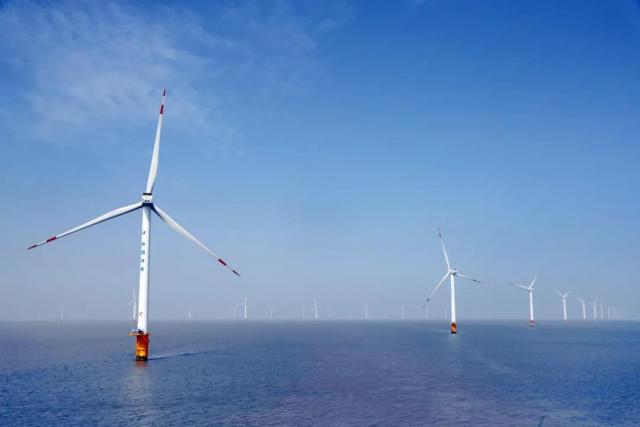浙侨英频 China boosts efforts to hit green targets

 An offshore wind farm is seen in Nantong, Jiangsu province, in May. [Photo by Xu CongjunFor China Daily]
An offshore wind farm is seen in Nantong, Jiangsu province, in May. [Photo by Xu CongjunFor China Daily]
Political Bureau urges faster rollout of action plan as climate change worsens
China is bolstering efforts to tackle climate change by proactively promoting low-carbon projects as drivers of economic growth and reining in sectors with high energy consumption and emissions, experts said.
In late July, a meeting of the Political Bureau of the Communist Party of China Central Committee had carbon emissions high on the agenda amid the worsening climate crisis that has seen extreme weather conditions across the globe.
The world's leading scientists warned in the Intergovernmental Panel on Climate Change report on Monday that climate change is widespread, rapid, and intensifying.
The human-caused climate crisis is unequivocal and temperatures are likely to rise by more than 1.5 ℃ over the next 20 years, triggering more extreme weather events worldwide, the report said. Many of the climate changes observed are unprecedented in thousands, if not hundreds of thousands of years, the report added.
The Political Bureau meeting urged a faster rollout of a national action plan to fulfill the country's target of reaching a carbon dioxide emissions peak before 2030, according to a statement released after the meeting.
Presided over by President Xi Jinping, who is also general secretary of the CPC Central Committee, the meeting set out key economic policy directions for the second half of this year.
Aside from adhering to coordinated national action, the meeting stressed the need to correct movement-style carbon reduction measures, as the country forges ahead to fulfill its climate targets, which also include achieving carbon neutrality before 2060.
Fu Sha, program director of Energy Foundation China's Low Carbon Economic Growth Program, said many regions have included the development of hydrogen energy in their 14th Five-Year Plan (2021-25).
An example of a movement-style measure is undertaking a hydrogen energy program without a proper assessment of local conditions. However, for the country to achieve its carbon neutrality target doesn't necessarily mean that each region needs to go carbon neutral, she said.
Some regions may not only be able to achieve negative emissions but can help make up the gap in other areas. Other regions may not have the suitable conditions to develop new energy industries.
Each region should proceed with carbon reduction in light of local conditions, she stressed, adding that different measures should be rolled out in a coordinated way.
The meeting called for the county's climate targets to proceed in a build first, destroy later manner. The development of projects with high energy consumption and emissions will be rigorously curbed, the release said.
Fu said China will prioritize low-carbon, clean industries in new projects to promote the construction of infrastructure for renewable energies.
As low-carbon projects start to dominate new developments, the country will target its historical stockpile of high-emission projects for further carbon reduction, she said.
In addition to infrastructure, policy and institutional mechanisms need to be put in place to create a favorable situation for the development of new energy and low-carbon industries.
Lin Boqiang, head of the China Institute for Studies in Energy Policy at Xiamen University, said only after the country builds the infrastructure for new energy, can it undertake large-scale reduction of the consumption of coal and other fossil fuels, which make up about 85 percent of China's energy mix.
The build first, destroy later strategy will help ensure energy security and a stable power supply to sustain economic growth, he said.
Steel, cement and the nonferrous metal industries are the main sectors with high energy consumption and emissions, and consume 21.5 percent of the country's power.
Efforts to contain these industries will reduce China's dependence on energy for economic development, and set the country on the path of high-quality development.
New projects with high energy consumption and emissions have been major targets of environmental inspections.
The inspection teams are usually headed by retired ministry-level officials, and these teams report to a central leading group headed by Vice-Premier Han Zheng.
Find more audio news on the China Daily app.
【背景阅读】
坚决纠正运动式“减碳”
新华社北京7月31日电 7月30日召开的中共中央政治局会议提出,要统筹有序做好碳达峰、碳中和工作,尽快出台2030年前碳达峰行动方案,坚持全国一盘棋,纠正运动式“减碳”,先立后破,坚决遏制“两高”项目盲目发展。
力争2030年前实现碳达峰、2060年前实现碳中和——我国提出的“双碳”目标彰显了坚定走绿色发展之路的决心,“做好碳达峰、碳中和工作”也被列为“十四五”开局之年的重点任务之一。
实现“双碳”目标,在我国并非易事。在肯定一些地方、企业积极行动的同时,也要看到,有一些地方在空喊口号、蹭热度,还有一些地方有过度行动的倾向,超过了目前的发展阶段。这种运动式“减碳”,一哄而上、缺乏统筹,可能会造成减排成本和效益难以达到最优,甚至可能影响到经济的正常发展。
也有一些地方出现将“碳达峰”曲解为“攀高峰”,认为2030年前还可以继续大幅提高化石能源使用量。近期中央生态环境保护督察就发现,一些地方存在盲目上马“两高”项目的冲动,有“大上、快上、抢上、乱上”的势头。如果任由“两高”项目盲目发展,碳排放增加速率快,碳排放会在一个相当高的水平达峰,造成后期碳中和要承担更大的压力和代价。
我国经济体量大,东中西部经济发展阶段、排放现状、减排潜力有很大差异。一些经济较为发达的城市,服务业比重高,高排放的工业产业转移到其他地区,碳达峰难度相对较小。有些地方承担的经济发展任务不同,产业结构偏重,面临的“减碳”任务更为艰巨。因此,需要全国一盘棋统筹考虑。
实现碳达峰、碳中和是一项复杂、长期和系统性的工程,需要科学部署目标任务、加强顶层设计。不论是地方、行业还是企业,都要合理设置目标,一切从实际出发,科学把握节奏。要处理好发展和减排、整体和局部、短期和中长期的关系,处理好减污降碳和能源安全、产业链供应链安全、粮食安全、群众正常生活的关系。
坚持全国一盘棋,统筹有序、科学“减碳”,我们会打赢碳达峰、碳中和的硬仗。
来源新华社


 侨情管理信息系统
侨情管理信息系统 公众号
公众号

 浙公网安备33010302003270号
浙公网安备33010302003270号